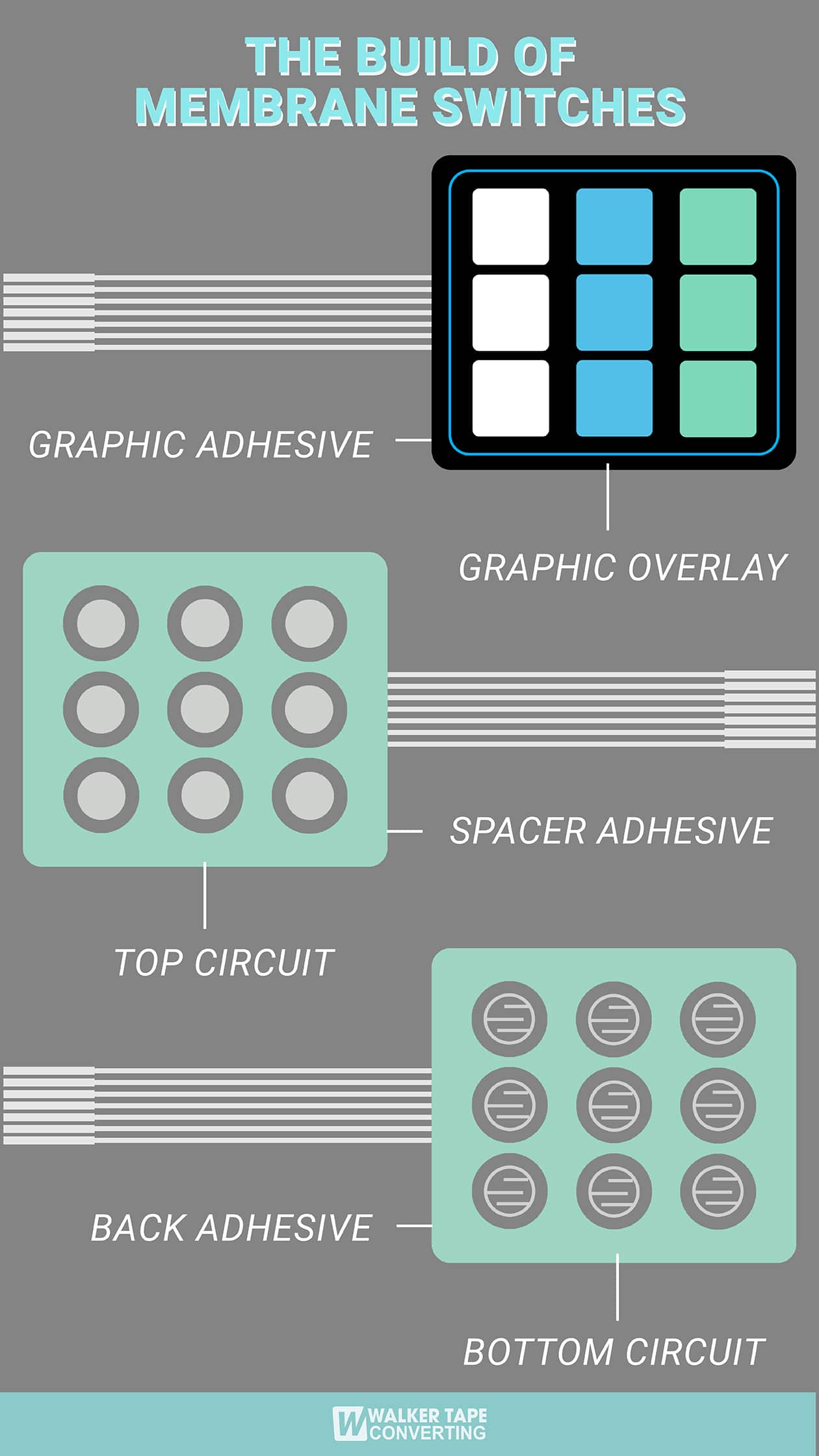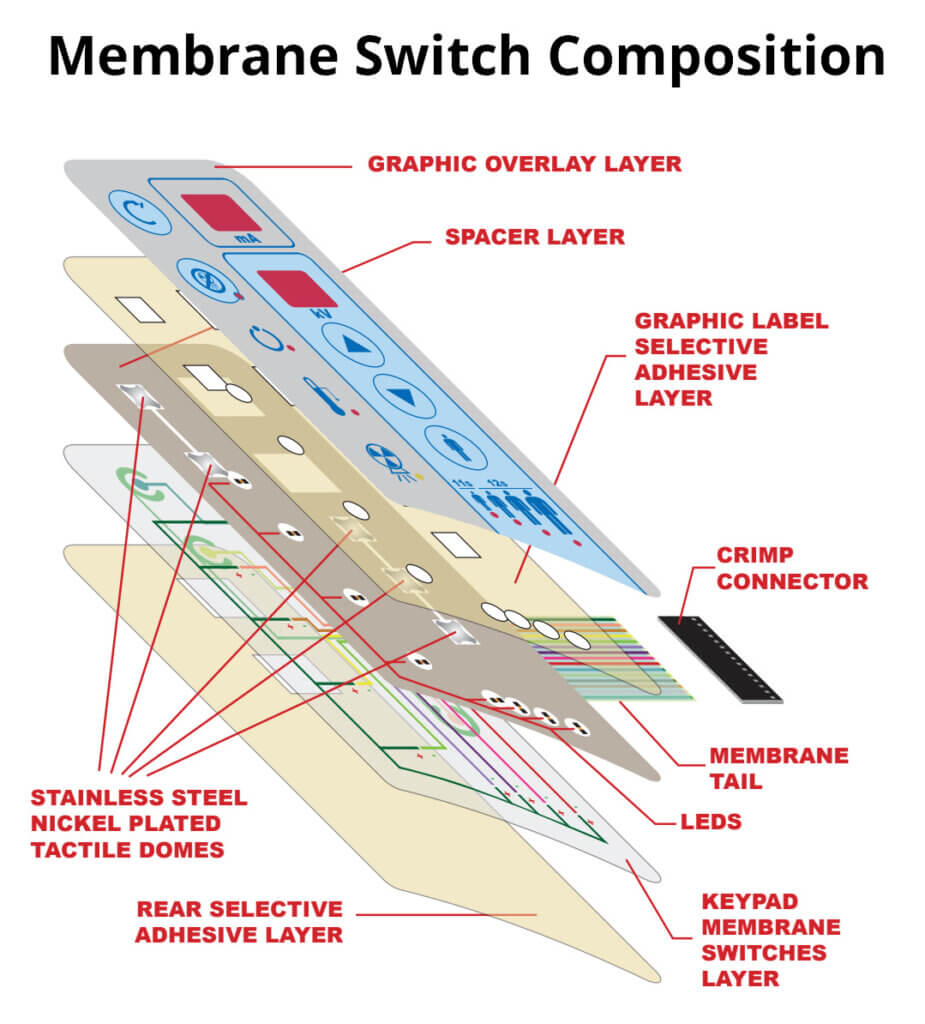Everything About Membrane Switch Over: A Comprehensive Overview for Beginners
Membrane layer switches are necessary elements in modern-day electronic devices, using an unique interface for individual communication - membrane switch. Their split construction, consisting of overlays and conductive traces, gives functionality and longevity. Unlike conventional mechanical buttons, membrane switches provide a streamlined design and adjustable alternatives. Comprehending their essential attributes and benefits can change product style. The details of their application and layout considerations require additional expedition.
What Is a Membrane layer Switch over?
A membrane layer button is a kind of electric switch that is composed of an adaptable membrane layer layered over a published motherboard. This layout enables a portable and streamlined user interface, often utilized in various electronic devices. Membrane layer buttons are generally located in customer devices, clinical devices, and industrial machinery due to their resilience and resistance to environmental factors.The construction generally includes multiple layers, such as visuals overlays and glue backing, which offer tactile responses and shield the wiring beneath. The operation of a membrane button is started when pressure is put on the surface, finishing an electric circuit.These switches are valued for their versatility, making it possible for personalized styles and printed graphics that provide to particular user interfaces. Their inconspicuous nature minimizes space needs, making them excellent for applications where standard switches might not fit. Generally, membrane buttons provide a aesthetic and useful service for modern digital devices.
Trick Parts of Membrane Layer Switches
Membrane layer switches make up several crucial components that add to their functionality and performance. The leading layer, called the overlay, gives the interface and is often published with graphics or symbols. Under the overlay lies a spacer layer, which separates the conductive components and avoids unintentional activation. The next important part is the visuals layer, which enhances appearances and guarantees the toughness of the design.Conductive traces, generally made from materials like silver or carbon, are published on the circuit layer. When stress is put on the overlay, these traces enter into get in touch with, completing the circuit. Furthermore, a backing layer offers structural assistance and can be made from materials such as polyester or polycarbonate. Together, these components create a trusted, straightforward interface suitable for numerous applications, from family home appliances to industrial equipment. Comprehending these aspects is essential for anybody thinking about membrane layer switch technology.
How Membrane Switches Work
Understanding just how membrane layer switches over function is essential for appreciating their prevalent usage in numerous tools. A membrane layer switch runs with a collection of layers, including a visuals overlay, spacer, and a circuit layer. When stress is put on the overlay, it compresses the spacer layer, allowing the circuit layer to make contact and finish an electric circuit. This activity sends out a signal to the gadget, triggering an action, such as activating a light or activating a function.Membrane switches can be made with numerous functions, including responsive comments, backlighting, and customized graphics, enhancing customer interaction. Their construction allows for a covered style, protecting the inner elements from dust, dampness, and pollutants. This longevity makes them ideal for diverse applications, from consumer electronic devices to industrial tools. Generally, the simplicity and effectiveness of membrane layer changes contribute to their appeal in modern-day technology.
Benefits of Membrane Layer Switches Mechanical Buttons
While mechanical switches have actually long been a staple in numerous tools, membrane changes deal unique benefits that make them progressively appealing. One significant benefit is their slim account, permitting even more portable designs and better flexibility in product growth. Additionally, membrane layer switches over attribute a consistent surface area, which improves visual appeal and streamlines cleansing, making them suitable for atmospheres where health is critical.Another benefit is their resistance to dust and wetness. Unlike mechanical buttons, which can be compromised by environmental aspects, membrane layer buttons offer a closed user interface that shields against pollutants - membrane switch. Membrane layer switches generally have a longer life expectancy due to fewer moving parts, resulting in improved toughness and reliability.Cost-effectiveness is additionally a remarkable advantage, as membrane layer buttons can be created in bulk with lower manufacturing costs. These factors combine to position membrane layer buttons as a functional alternative to conventional mechanical choices in numerous applications
Common Applications of Membrane Layer Switches
Membrane layer buttons are extensively made use of in different industries, particularly in consumer electronic devices and industrial control panels. In customer gadgets, they offer a sleek, straightforward interface, while in industrial setups, they improve sturdiness and functionality. Recognizing these applications highlights the adaptability and practicality of membrane layer switches in modern innovation.
Consumer Electronic Devices Gadgets
As customer electronics remain to progress, membrane switches have actually ended up being a popular selection for a range of tools because of their versatility and smooth design. These switches are generally discovered in smart devices, tablet computers, and remote controls, where area is limited and aesthetics issue. Their reduced profile and adjustable layouts allow makers to create easy to use user interfaces that boost the overall individual experience. Furthermore, membrane layer switches are commonly utilized in devices such as microwaves and coffee machine, providing instinctive control alternatives while resisting wetness and dirt. The toughness and reliability of membrane switches over make them ideal for everyday consumer products, guaranteeing durability and regular efficiency. On the whole, their assimilation in consumer electronics mirrors a mix of functionality and contemporary layout.
Industrial Control Panels
The applications of membrane switches over expand beyond customer electronics, discovering substantial use in industrial control board. These switches are favored for their sturdiness and resistance to harsh atmospheres, making them suitable for making and procedure control settings. They provide a reputable user interface for operators to control equipment, screen processes, and adjust settings. Membrane layer buttons can be personalized to fit specific functional needs, integrating features like backlighting and tactile responses, improving individual experience. Their low-profile style allows for integration right into various devices, while their capacity to hold up against spills, dirt, and severe temperatures assurances longevity. On the whole, membrane layer switches add to efficient and secure operation in industrial applications, showing their convenience and effectiveness in requiring atmospheres.
Factors To Consider for Designing Membrane Switches
When developing membrane switches, selecting the best materials is necessary to guarantee durability and functionality. Additionally, understanding layer arrangement methods can greatly affect the button's performance and customer experience. These factors to consider play an essential role in producing reliable and reputable membrane layer switch styles.
Product Option Significance
Product choice plays a vital duty in the layout and capability of membrane switches. The selected materials directly influence the button's resilience, responsive response, and overall aesthetic. Secret factors to consider include the substrate, which have to give structural honesty while allowing for versatility, and the graphic overlay, which requires to be resistant anonymous to put on and ecological elements. Conductive products need to guarantee trusted electric performance, while adhesives should use strong bonding without endangering the button's operation. Additionally, compatibility with producing processes and end-user environments is vital; materials need to endure differing temperature levels, moisture degrees, and chemical exposure. Ultimately, proper material choice not only enhances the membrane switch's efficiency however likewise contributes to its durability and individual complete satisfaction, making it a critical element of the layout process.

Layer Arrangement Strategies

Frequently Asked Inquiries
The Length Of Time Do Membrane Switches Generally Last?
Membrane layer buttons typically have a life-span of 1 to 5 million cycles, relying on use and environmental problems. Factors such as design quality and operating regularity greatly influence their sturdiness and total performance long life.

Can Membrane Layer Changes Be Customized for Certain Designs?
Membrane layer switches can certainly be personalized to fit details layouts, enabling varied shapes, colors, and functionalities. This adaptability makes it possible click to read for manufacturers to customize these buttons to satisfy special visual and operational requirements efficiently.
What Products Are Made Use Of in Membrane Switch Building?
Membrane buttons are generally built making use of materials such as polyester, polycarbonate, and adhesive layers. These materials offer durability, resistance, and flexibility to environmental factors, making certain the buttons operate effectively in different applications and conditions.
Are Membrane Layer Switches Immune or waterproof to Wetness?
Membrane switches can be designed to be moisture-resistant, using specialized materials and finishings. Their water-proof capacities depend on building and construction top quality and certain applications, making it important to examine needs for optimal efficiency in different settings.
How Are Membrane Layer Switches Over Fixed if Damaged?
Repairing damaged membrane layer changes normally involves replacing the affected layer or circuit. Professionals might likewise apply conductive adhesive or make use of specialized repair service packages, making sure capability is recovered without complete replacement of the whole switch setting up. Unlike traditional mechanical switches, membrane switches offer a sleek style and customizable alternatives. A membrane switch is a kind of electrical button that consists of a versatile membrane layered over a published circuit board. The procedure of a membrane switch is initiated when stress is applied to the surface, finishing an electrical circuit.These switches are valued for their convenience, enabling custom styles and published graphics that provide to particular user interfaces. While mechanical buttons have long been a staple in numerous tools, membrane layer switches over offer unique advantages that make them progressively appealing. Membrane layer buttons typically have a longer life expectancy due to less moving parts, resulting in improved toughness and reliability.Cost-effectiveness is also a noteworthy advantage, as membrane buttons can be created in bulk with reduced manufacturing expenses.
Comments on “Membrane switch and aesthetics: How to align function with form”